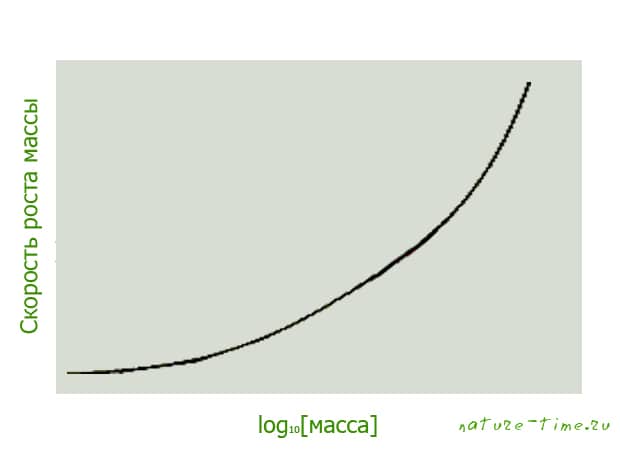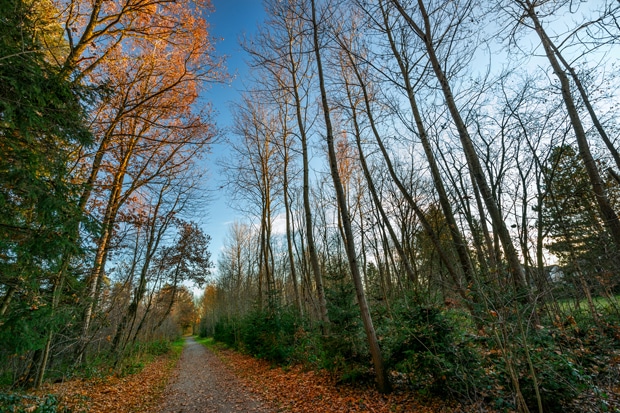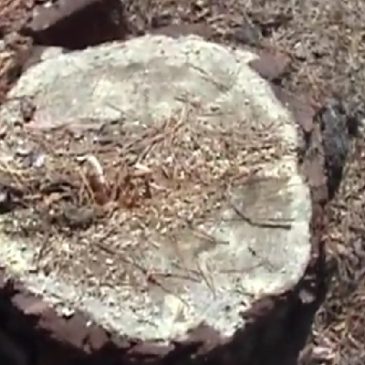Normally, living beings, including us, have a period of active growth in youth, but as we age, growth body slows down or stops altogether. The growth rate of trees in height has the same character. After a period of active growth in height, the growth rate of the tree decreases, and it begins to gain mass due to the trunk and side shoots. The figure shows the general nature of the dependence of the height of the majority of a tree on its age. The schedule is divided into three phases. 1 - this is the initial phase of slow growth, followed by a phase of rapid growth - 2. When the tree approaches a certain height, growth rates fall - 3 phase. Of course, the time and height values will be different for each individual tree, depending on the characteristics of the species and environmental conditions.
The general nature of the dependence of the height of most trees on age
Different types of trees grow at different rates. Depending on the growth rate, trees are usually divided into groups. In tables 1 and 2, the trees are divided into groups depending on the rate of tree growth per year. Trees gain such growth rates during the active phase (at the age of 10 to 30 years).
Table 1: Fast growing and moderate growing trees
|
Very fast growing |
fast growing |
moderately growing |
||
|
increment >= 2 m |
growth<= 1 м |
growth 0.5-0.6 m |
||
|
Deciduous |
Conifers |
Deciduous |
Conifers |
|
|
White acacia Birch Gledichia Willow Willow Maple Maple Paulownia Poplar Eucalyptus |
Elm Elm Oak Catalpa Nut Nut Tulip Mulberry Ash Ash Ash |
Norway spruce European larch Siberian larch Pseudotsuga tissolifolia Weymouth pine Scotch pine |
Amur velvet Common hornbeam Rock Oak Pedunculate oak Large-leaved linden Linden small-leaved Linden silver |
Prickly spruce Siberian fir Thuja western |
Table 2: Slow growing trees
|
slow growing |
Very slow growing |
|
|
growth 0.25-0.2 m |
gain 0.15 cm |
|
|
Deciduous |
Conifers |
|
|
forest pear pear pistachio tree forest apple tree Siberian apple tree |
Siberian cedar pine Arbor vitae |
Dwarf forms of deciduous (Dwarf willows) Dwarf forms of conifers (cypress blunt) Cedar elfin Yew berry |
Tree Mass Growth Rate
It used to be thought that large trees were less productive at capturing carbon dioxide. However, recently, on January 15, 2014, research data was published in the journal Nature, indicating the opposite. The study was conducted by a team of international scientists led by Nate L. Stephenson of the American Environmental Research Center (Western Ecological Research Center).
The scientists reviewed records from studies across six continents collected over the past 80+ years, and based their conclusions on repeated measurements of 673,046 individual trees.
“Large, old trees act not just as aging reservoirs of carbon, but also actively sequester a large amount of carbon compared to small trees ... In some situations, one large tree can add as much carbon to the forest mass in a year as is contained in the entire medium-sized tree ".
The main problem is the perception of scale. Stevenson says it's difficult to see the growth of a large tree because it's already huge. With age in thickness the tree adds less, but the larger the diameter, the more surface area grows. A tree can grow in height over many years, but at a certain point it reaches its peak and then begins to increase in trunk diameter, increases the number of branches and leaves.
The researchers write:
“Most likely, the rapid growth of giant trees is the global norm and can exceed 600 kg per year in the largest specimens.”
Stevenson also says that if people grew at this rate, they could weigh half a ton in middle age, and well over a ton by retirement.
The figure shows the general nature of the dependence of the tree mass growth rate on the decimal logarithm of the tree mass given in the article.

As a result of human activity and for other reasons, vast areas of ancient forests are being destroyed. . Trees play a very important role in existing ecosystems, so it is vital for us to protect forests from destruction.

(Viewed192 307 | Viewed today 253)
 Ecological problems of the ocean. 5 threats to the future
Ecological problems of the ocean. 5 threats to the future
 Deforestation is one of the environmental problems in Russia
Deforestation is one of the environmental problems in Russia
